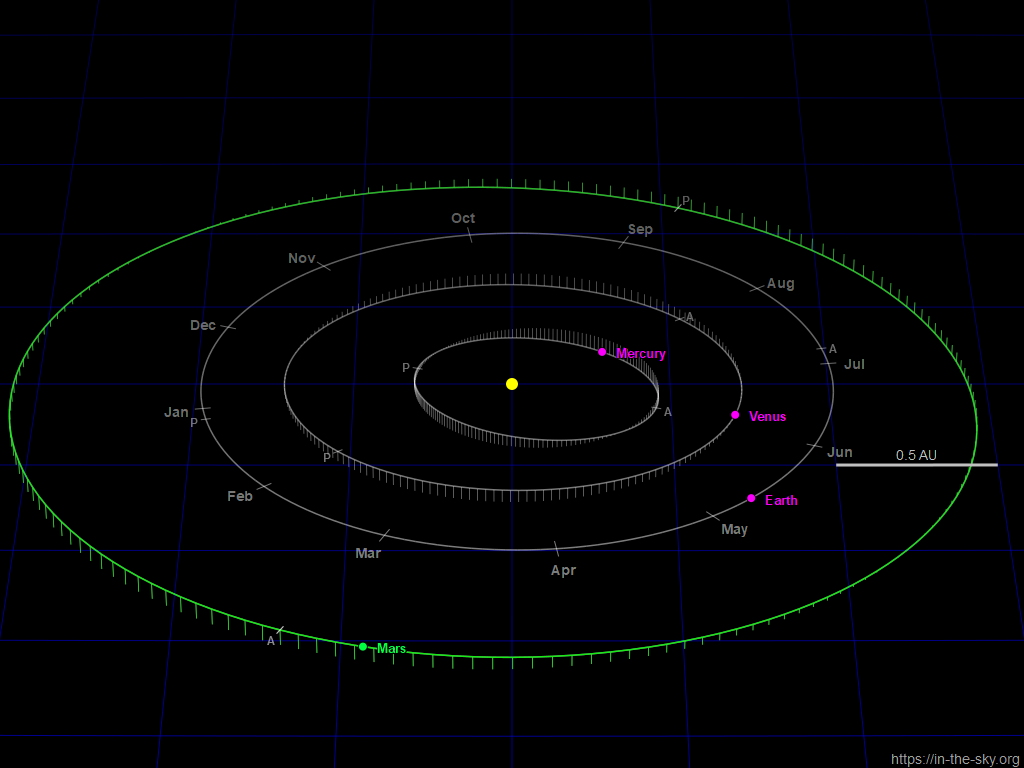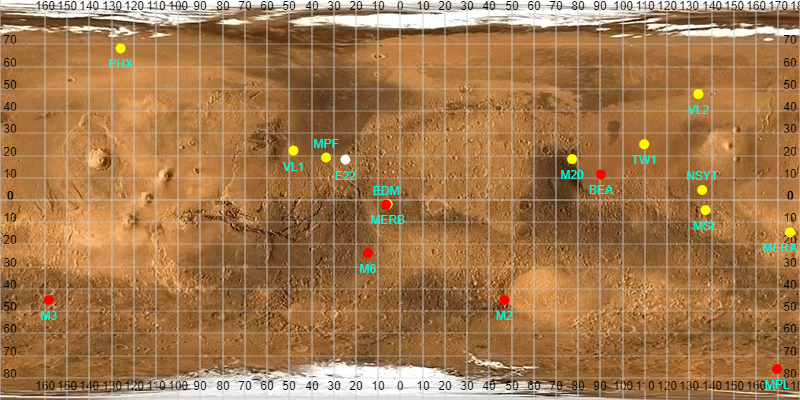Table of Contents
Mars Weather
| Weather Reports |
|---|
| Insight Lander |
| Perseverance Rover |
| Curiosity data to come |
 Image courtesy of https://in-the-sky.org and © Dominic Ford
Image courtesy of https://in-the-sky.org and © Dominic Ford
This image is updated on the 1st and 7th of every month, and every Saturday. A daily update is available on the Mars Solar Conjunctions page when such events are active.
You can check the position of Mars vs the Sun and Earth for any date here:
https://in-the-sky.org/solarsystem.php?obj=P4
Follow Conjunctions as they occur.
Martian Day
The Martian day is 39 mins 35.244 secs longer than a standard day. This means that approx every 36.1 days the Earth weather date skips a day while the Martian Sol marches on as normal. You can see this in the Insight data. April 16th 2019 seems to be missing, yet the Sols on April 15th and April 17th are consecutive.
Current Time on Mars
The Martian day - or sol - is 24hrs 39mins 35secs long. For convenience, Martian clocks keep a 24hr time, requiring the Martian second to be a little longer than it is on Earth (approx 1.0275 secs).
These clocks reflect the local times at the prime meridian, InSight's location, Curiosity's location and Persevance's location and keep Martian time (using its extended seconds). InSight was intended to land at 135.974°E, but actually landed at 135.6234°E. The InSight Clock uses the actual landing site, while the Mission Clock (used by the mission team) uses the intended landing site. As Curiosity and Perseverance are Rovers, and their exact positions cannot be determined, a fixed position within the craters are used and reflect the mission clocks used by the mission teams.
LS is the solar longitude - the angular position of the planet from the vernal equinox - and is important in many equations, particularly regarding time and dates. The value displayed here differs from that at James Tauber's Mars Clock, which itself differs from the value displayed by Mars24. I had to choose one of them as my benchmark, and since I use Mars24 as the benchmark for the clocks, it seemed reasonable to choose Mars24 to remain consistent. The difference between the two (Mars24 and Tauber's algorithm) is only 0.00628° anyway, but otherwise they are in lock-step.
Although LS effectively describes the planet's position in its orbit around the sun, it is actually a function of time on the planetary analemma, since it describes the position on the analemma for a certain date and time.
MSD is the Martian equivalent of a Julian date, and this refers to the number of sols since Dec 29th 1873. For obvious reasons, this keeps Martian time. Note: if you use the Mars24 program, you may note the MSD displayed in that program differs slightly from this one. It seems Mars24 rounds the numbers, so when MSD reaches a 0.005 precision boundary, it rounds up. It doesn't seem to do this for MJD.
MJD is the Modified Julian Date. This ignores the first 2,400,000 days in the standard Julian date, and moves the starting point to midnight (from midday). This is further modified to reflect the coordinated universal time for spacecraft, which is some 5hrs 45m adrift of UTC.
Since MSD uses Martian time and MJD uses universal time, you'll see them slide in and out of synchronicity.
There are several Martian Calendars in use. NASA uses MSD, but the year/month calculations in the above clocks use the calendar proposed by R. Todd Clancy (Clancy et al., Journal of Geophys. Res 105, p 9553, 2000), whereby the Calendar begins at midnight on the morning of April 11th 1955 (when Ls = 0) and with the first year being year 1.
Martian years are approx. 686 Earth days long, equating to roughly 668 sols. Sols are counted from the start of the year because of the huge variance in the length of Martian months, which vary in duration from 46 to 67 sols.
Martian months are calculated based on the number of degrees Mars is around its orbit (each month being 30°). This means most months end partway through the day. In order to ensure a month consists of whole days, the calculation employed here rounds down to the nearest whole number. Therefore, if the end of the month occurs on sol 68.2, all of sol 68 occurs in the last day of the month. This is a convenience, and there is no formal convention on how to handle this. Other calculators may begin a month on any day where the month begins, so in the above example, sol 68 may be the first sol in the new month.
If you are wondering why the sols on the clocks don't match the sols in the weather reports, the weather reports refer to mission time, rather than the start of the Martian year. Besides being a convenient way to track mission duration, it guarantees two data points in different years have unique sol counts.
Current Location of Mars
[1] the calculation is based on data from the Planetary Society, and divides the Martian year using the equinoxes and solstices. Further, it uses UTC to perform the calculations rather than Airy Mean Time (AMT), so is only an approximation to provide a rough guide. AMT is the Martian equivalent of GMT. The Martian year is 686.97 standard days (668.6 sols), approximately 1.88 years.
[2] Calculation is based on data from Goddard Institute for Space Studies
[3] Calculation is based on data from Goddard Institute for Space Studies and other sources
